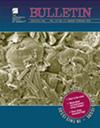Two-phase kinematic evolution of the Qilian Shan, northern Tibetan Plateau: Initial Eocene−Oligocene deformation that accelerated in the mid-Miocene
IF 3.7
1区 地球科学
Q1 GEOSCIENCES, MULTIDISCIPLINARY
引用次数: 0
Abstract
The Cenozoic growth of the Tibetan Plateau and the distribution of deformation across it are a consequence of India-Asia collision and continued convergence, which have implications for studies of continental tectonics. The spatio-temporal development of Cenozoic deformation along the northern margin of the plateau is an important issue that can be better understood by testing various models of plateau growth. The northern Tibetan Plateau is bounded by the Cenozoic Qilian Shan thrust belt and the Haiyuan left-slip fault. We conducted geologic mapping, field observations, electron spin resonance (ESR) dating, and apatite (U-Th)/He (AHe) and apatite fission-track (AFT) analysis in the Qilian Shan thrust belt to improve our understanding of the timing of brittle faulting and range exhumation in the northern Tibetan Plateau. We document the first direct age constraints for Oligocene deformation within the central Qilian Shan via ESR dating, which correlates with AHe-AFT cooling ages in adjacent ranges. We demonstrate that the Qilian Shan thrust belt experienced a two-phase growth history, including Eocene−Oligocene fault-related uplift shortly after the India-Asia convergence, and mid-Miocene regional overprinting deformation that reactivated the proximal thrust faults. This deformational pattern suggests that the Qilian Shan thrust belt has experienced out-of-sequence development since the Eocene−Oligocene and has persisted as the stationary northeastern boundary of the Himalayan-Tibetan Orogen throughout the Cenozoic. The Paleozoic Qilian suture systems acted as a pre-existing weakness and played a decisive role in controlling the lithospheric rheology, which therefore impacted the timing, pattern, and strain distribution of Cenozoic deformation across the northern Tibetan Plateau.青藏高原北部祁连山的两阶段运动演化:始新世-渐新世早期变形在中新世中期加速
青藏高原新生代的发育和变形分布是印度-亚洲碰撞和持续辐合的结果,对大陆构造研究具有重要意义。高原北缘新生代变形的时空发展是一个重要的问题,可以通过测试各种高原生长模型来更好地理解。青藏高原北部以新生代祁连山逆冲带和海原左滑断裂为界。通过地质填图、野外观测、电子自旋共振(ESR)定年、磷灰石(U-Th)/He (AHe)和磷灰石裂变径迹(AFT)分析等方法,对青藏高原北部祁连山冲断带进行了地质填图、野外观测等研究。我们通过ESR测年首次记录了祁连山中部渐新世变形的直接年龄约束,这与邻近范围的ae - he - aft冷却年龄相关。研究表明,祁连山冲断带经历了始新世—渐新世断裂相关隆升和中新世中期区域叠合变形两阶段的发育过程,这两阶段的叠合变形使近端冲断断裂重新活化。这种变形模式表明祁连山冲断带自始新世—渐新世以来经历了序外发育,并在整个新生代一直是喜马拉雅—青藏造山带的静止东北边界。古生代祁连缝合线系在控制岩石圈流变学方面起着决定性作用,影响了青藏高原北部地区新生代变形的时间、模式和应变分布。
本文章由计算机程序翻译,如有差异,请以英文原文为准。
求助全文
约1分钟内获得全文
求助全文
来源期刊

Geological Society of America Bulletin
地学-地球科学综合
CiteScore
9.30
自引率
8.20%
发文量
159
审稿时长
4-8 weeks
期刊介绍:
The GSA Bulletin is the Society''s premier scholarly journal, published continuously since 1890. Its first editor was William John (WJ) McGee, who was responsible for establishing much of its original style and format. Fully refereed, each bimonthly issue includes 16-20 papers focusing on the most definitive, timely, and classic-style research in all earth-science disciplines. The Bulletin welcomes most contributions that are data-rich, mature studies of broad interest (i.e., of interest to more than one sub-discipline of earth science) and of lasting, archival quality. These include (but are not limited to) studies related to tectonics, structural geology, geochemistry, geophysics, hydrogeology, marine geology, paleoclimatology, planetary geology, quaternary geology/geomorphology, sedimentary geology, stratigraphy, and volcanology. The journal is committed to further developing both the scope of its content and its international profile so that it publishes the most current earth science research that will be of wide interest to geoscientists.
 求助内容:
求助内容: 应助结果提醒方式:
应助结果提醒方式:


